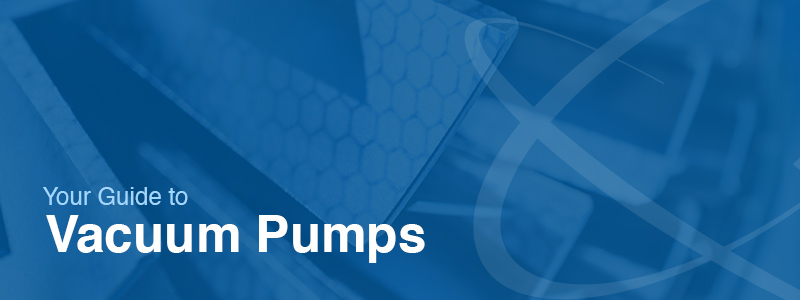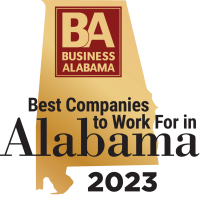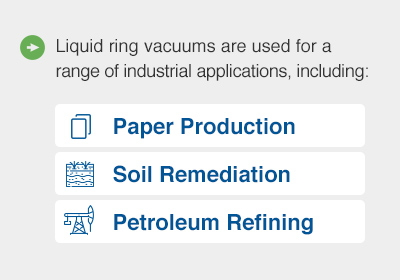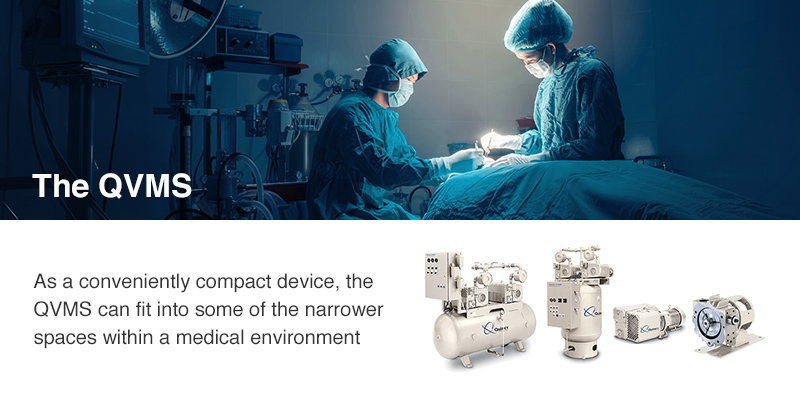
Across a vast range of industries, the vacuum pump is utilized for various applications, from the packaging of goods to the removal of moisture. From hospitals and commercial pressing plants to factories where automobiles and airplanes are assembled, industrial vacuum pumps make operations easier, cleaner and more sanitary.
In order to serve the vast range of needs for such technology, a handful of different vacuum pump types have been developed over the past century. Some vacuum pumps are more suited for commercial manufacturing, while others are better equipped for hospitals and service industries. Whatever demands might exist within an industry, there’s no doubt a vacuum pump is capable of fulfilling each demand and offering maximum performance benefits.
Contact Us Learn More Find a Dealer Near You
Liquid Ring Vacuums
A liquid ring vacuum consists of a rotating positive-displacement pump that is sealed by a ring of liquid around the inner diameter of the pumping chamber. The functions of a liquid ring vacuum are similar to that of a rotary vane vacuum. Overall, the design of a liquid ring vacuum is low friction, and the only part that moves is the rotor. Any sliding friction that might occur is confined to the shaft seals. In most cases, induction motors are responsible for powering liquid ring vacuums.
The liquid ring vacuum pump is designed to handle heavy-duty industrial applications in wet environments that would be more difficult for other vacuum types. The function of the vacuum is built around a friction-free, rotating impeller. Air is sucked into the pump, compressed with a liquid, and then driven outward. There are many chambers created by the impeller, therefore the pump is expelling compressed gas continuously during rotation.
The first liquid ring pump of any kind was patented in Germany by Siemens-Schuckert in 1903.
Liquid ring vacuums are produced in both single and multistage varieties. With the latter type, two compression stages are employed. In certain systems, the ring liquid is removed from the gas by external components, where the liquid is cooled before being sent back to the casing.
Liquid ring vacuums are used for a range of industrial applications, including paper production, soil remediation and petroleum refining. In factories with steam-turbine generators, liquid ring vacuums are employed to suck incondensable gas from the scene. For industrial setups with paper machines, liquid ring vacuums are used to remove water from pulp slurry and press felts. Liquid ring vacuums are also used to form the mold papers used for egg cartons and similar commercial packing supplies.
Additional uses of liquid ring vacuums include the drawing of groundwater from wells for the purpose of soil remediation. In the field of petroleum refining, liquid ring vacuums are used for distillation purposes. Liquid ring vacuums are even used for the purpose of vapor recovery.
A liquid ring vacuum will accept any liquid with the right vapor pressure qualities. In most applications, water is used as the sealant, with oil being a distant second. Therefore, liquid ring vacuums that are oil-sealed generally need to be cooled with air.
The liquid ring vacuum has long been established as the most ideal pump for handling extreme vapor loads. In processes that involve distillation, evaporation and other condensable tasks, liquid ring vacuums are the best technology for handling wet as well as dry gases that carry liquid. Quincy sells liquid ring vacuums in both single and dual-stage designs, which makes the technology applicable for a whole host of industrial demands.
Rotary Vane Vacuum
A rotary vane vacuum consists of a positive-displacement pump that drives sliding vanes that are mounted on a rotor. In many units of this type, the length of the vanes will vary in order to stay in contact with the rotor pumps throughout each revolution. The first unit of its kind was patented in 1874 by Sackville, New Brunswick inventor Charles C. Barnes.
In its simplest of designs, a rotary vane vacuum will contain a circular rotor that moves within a big, round cavity. Eccentricity of motion is caused by the positioning of the rotor within the cavity, because the centers of the two are never aligned to one another. Vane chambers are formed by the movement of the vanes.
At the side of the vacuum where fluid enters, the volume of the vane chamber rises. This creates pressure that pulls in the fluid. At the other end of the vacuum, the vane chamber loosens, and this causes fluid to exit the pump. The preceding series of actions process the same amount of fluid many times per revolution.
Rotary vane vacuums are used for a whole host of applications in the automotive and aerospace industries. In the rotary vane vacuum, gas and oil are combined inside the pump. Therefore, the process of separating gas and oil must be done at the outlet chamber.
The QV series of all-purpose, rotary vane vacuum pumps is comprised of 13 different models, all of which are high-capacity and can therefore handle a series of demands.
In terms of horsepower, rotary vacuum pumps range from 1.5 HP to 10 HP. The primary features of the QV include an inlet check valve, a direct-drive NEMA motor and a multistage separation system.
Dry Claw
Vacuum pump types of this sort provide optimal performance with minimal noise and maximum safety.
Claw pumps are often used in the industries of packing, printing, wood processing and wastewater management. In factories where pneumatic machines and conveyors are used, claw pumps are generally considered to be highly beneficial to the system as a whole.
Claw pumps are comprised of twin rotors that turn in opposite circles, one clockwise and the other counterclockwise. The two rotors never come into contact. For each revolution, the claw of the vacuum crosses a suction connection, and this brings gas into the compression chamber.
With the rotors turning, the gas is transferred between the suction and pressure end of the vacuum. As the volume decreases between the rotors, the gas is compressed and discharged.
Quincy’s QCV Dry Claw line boasts design innovations that have taken claw pump technology to a whole new level. Dry claw vacuum pumps are considered the optimal choice for a variety of uses due to the mechanical strength, efficiency and design simplicity behind such technology. With many satisfied users across a range of industries, the dry claw vacuum has been tested and refined time and again to ensure that users receive the guaranteed high performance for many years to come with pumps within this category.
The QVMS
In hospitals, the direct-drive vacuum is relied upon for a number of highly sensitive applications. The one vacuum pump rated for medical services is the QVMS from Quincy — a direct-drive vacuum compressor with 2-10 hp and 8-378 scfm capacity.
As a conveniently compact device, the QVMS can fit into some of the narrower spaces within a medical environment, and is thus ideal for the broadest range of hospital uses. Furthermore, the QVMS is easy to set up and commission, which makes it a device for any medical establishment.
As far as maintenance is concerned, the QVMS is an easy unit to handle because of its single-sided access, which makes it easier to pinpoint the root of a problem. Driven by Quincy’s QV vacuum pump, the QVMS also boasts a multistage separator, gas ballast, inlet check valves and a strong TEFC motor.
The QSV and QSVI
The QSV is a rough vacuum pump with a multitude of functions. The variable drive is popular in the food preparation industry for the following functions:
• Preserving
• Form shaping
• Holding, lifting, moving
• Cleaning environments
• Degassing
• Distillation
• Cooling and drying
Preserving encompasses the packaging of perishable goods such as meats, which need to be sealed in air–tight plastic encasement to prevent rot and exposure to the elements. The vacuum is also used to remove air from zip–locked perishables such as cheese and beef jerky, as well as sealed–container foods like peanuts.
Form shaping involves the formation of shaped plastic and glass products, such as bottles, jars, hot tubs and plastic food containers.
Holding, lifting and moving is the process that occurs on conveyer belts in factories, where products are held in place and rolled along from one stage of the production line and then moved or lifted to another. Numerous consumable goods undergo this process, from loafs of bread to cans of fruits. Envelope manufacturing, box assembling and even woodworking can also be accomplished with the holding and moving functions.
The cleaning of environments would involve any application where the vacuum is used to prevent airborne particles of any kind from landing on a product, such as computer chips. Alternately, the QVS can be used to control the environment, such as when the vacuum is used to create suction in order to mimic the environment of outer space.
Degassing involves the removal of gas and air molecules from liquids. Cooling drying is employed to cool products with large amounts of water. The Quincy QVS vacuum pump can produce anywhere from 7.5 to 50 hp and between 240 and 1120 cfm.
For demanding applications in a variety of other environments, the Quincy QSVI is generally considered to be the direct-drive vacuum of choice.
Another unique feature of the QSVI is its programming capabilities, which allow it to be set for ongoing, stop/start operations. Additional features of the vacuum include a modulating inlet valve, instrumental control panel, fluid filter and magnetic motor. The Quincy QSVI direct-drive vacuum pump is capable of producing anywhere from 25 to 200 hp and as much as 3000 scfm.
Industrial Vacuum Pumps From Quincy Compressor
Industrial vacuum pumps serve a variety of manufacturing and scientific purposes, and therefore play a significant role in the implementation of services and the production of items that people access and use on a daily basis.
Since the 1920s, Quincy has been a leading supplier of vacuum pumps for various uses. In factories where products are manufactured, the vacuum pump is used for the purpose of moisture removal.
Any given number of products you see on the shelves of stores on a daily basis are likely there in part thanks to Quincy. By the same token, the vehicles that bring these products to the shelves, much like the vehicles that traffic the highways, have been produced with vacuums and compressors that bear the Quincy brand name.
Regardless of the size or scope of a given production, compressed-air technology is likely to play a crucial role in various applications along each stage. Whether your operations happen to be large or small, chances are that vacuum pumps and other air devices could seriously aid in the completion of products and fulfillment of services. Here at Quincy, each vacuum pump we sell is designed to offer maximum performance and efficiency with minimal maintenance for many years to come.
Across the globe, Quincy is the most trusted name in air compressors and vacuum pumps, because our machines have consistently proven to be durable as well as optimal for nearly 100 years. Furthermore, we offer extended warranty plans on the rotary screw and reciprocating machines in our catalog. To learn more about the vacuum pumps we offer, click on over to our sales and service locator page today.





